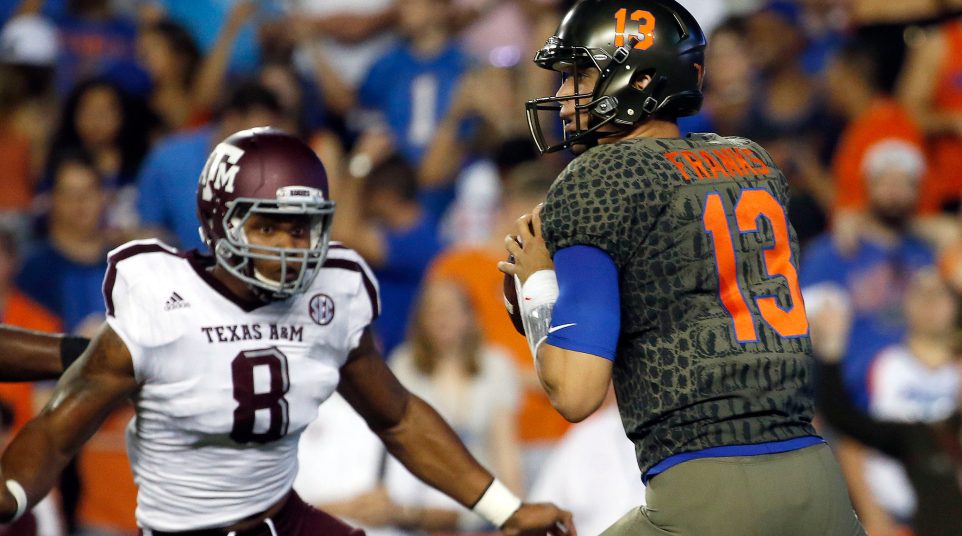
Can the Florida offense be fixed?
In their comeback win Sept. 23 against the Kentucky Wildcats, the Florida Gators discovered that they had some pretty high potential on offense if they would play a quarterback who could manage the game and keep the unit on track with consistent reads and decisions to get the ball into the hands of playmakers. Then their game manager, Luke Del Rio, went down with injury the following week and UF turned back to redshirt freshman Feleipe Franks.
With Franks at the helm the physical potential of Florida’s offense is higher than it has been in several years but the Gators have struggled to make good. In their 19-17 home loss to Texas A&M on Saturday, Florida’s inability to leverage all of their advantages and put points on the board was costly.
The Gators’ foundation on offense
Florida has a pretty good running game and has had one throughout Jim McElwain’s time as head coach. The numbers haven’t always been brilliant but considering how little support the running game tends to get from the passing attack, the numbers are actually quite good.
Against the Aggies, Florida ran the ball 42 times for 242 yards, or 5.8 yards per carry. Without Feleipe Franks, who was sacked five times and had an amusing 79-yard scamper, the Gators had 33 carries for 160 yards, or 4.8 a carry. Nothing tremendous but certainly a solid, chain-moving effort which has been typical since McElwain took over.
Here’s a good example of how their run game looked against the Aggie defense:
It’s hard to do much better than that against this type of defensive look. Even though it’s second and 14, the Aggies have all of their linebackers packed tight in the box with the two inside linebackers fast flowing to the football while their cornerbacks play tight coverage outside. The Aggies played a lot of press-man coverage and press quarters, regularly freeing up safeties like Armani Watts and Derrick Tucker to limit the damage when Florida backs leaked through the front, as happened here.
The problem for the Gators was passing. Franks was 17-for-26 (65 percent) for only 129 yards, 5 yards per attempt, and two interceptions to boot. When a team runs consistently and commands attention from an opposing defense, as Florida did in this game, but the shots its takes in the passing game don’t punish the defense, it’s not worth much.
Problems for the Gator passing game
Florida runs a pro-style offense, both in the sense that fans commonly perceive to be pro-style and in the truer sense of how things are done today in the pros. The offense is built off the running game and formations that feature tight ends helping to block, which isn’t quite as common for modern NFL offenses. The quarterback has a lot on his shoulders in identifying blitzes, setting protections and beating coverage with West Coast passing concepts, the approach which defines modern NFL offense.
It’s similar in some respects to Jim Harbaugh’s offense at Michigan, or more precisely to A.J. McCarron’s offenses at Alabama. The challenge to this style is that mastering run blocking, to the extent necessary for a solid ground game, leaves less time to nail down protections and reads when the quarterback drops back. It’s rather evident that Florida hasn’t nailed down pass protection…
…or QB progressions…
…to the same degree that the Gators have nailed down run-blocking schemes. The Aggies exacerbated those issues by playing a lot of press coverage, designed to deny Franks easy reads, and playing it behind five-man blitzes designed to hurry him. By the fourth quarter Franks was staring down routes designed to be open against coverages the Gators had seen, tipping off where the ball was going.
Simplifying all of this for a young quarterback often separates college offensive coordinators. One of Florida’s solutions Saturday was to show Aggies with obvious run formations, then try to create play-action opportunities off those looks.
The Aggies weren’t fooled.
A solution that could have long-term positive impact for the Gators is to invest more time in their spread dropback passing game. Much like the even less imaginative Tennessee Volunteers, when Florida really needs to throw to pick up a first down, it often lines up in a rather obvious 11 personnel spread set and hopes that this nominal “spreading the field” will result in simpler reads and open receivers.
But of course today’s defenses are designed to defend the spread and SEC defenses aren’t remotely threatened by defending a few simple concepts from Florida’s spread formation.
Florida needs to borrow from updated pro-style minds like Harbaugh’s and use its versatile tight ends and highly skilled receivers to create matchups and easier reads for their young QB. For instance:

Defenses tend to account for receivers from the outside in. They match their cornerbacks and best coverage safety with the outside receivers and outermost slot first, then match the innermost receivers with defenders who can also play the run in the box.
Florida could roll out two-tight end sets then send the RB and TEs out wide to be covered by the better coverage defenders. Then the Gators could stack their best receivers inside for quick-hitting routes against the worst coverage defenders. The nature of the formation would require rather obvious responses from the defense, particularly on a standard down, and simplify the read for Franks. He’d often simply identify the best matchup before the snap and throwing to the receiver who is open against a linebacker.
In the long-term, Florida’s offense will probably be just fine as Franks grows more accustomed to the existing answers in McElwain’s offense for beating blitzes, press coverage, and other defensive strategies. In the meantime though, the Gators could stand to steal some modern ideas from the pros on how to make pro-style offense more accessible.




